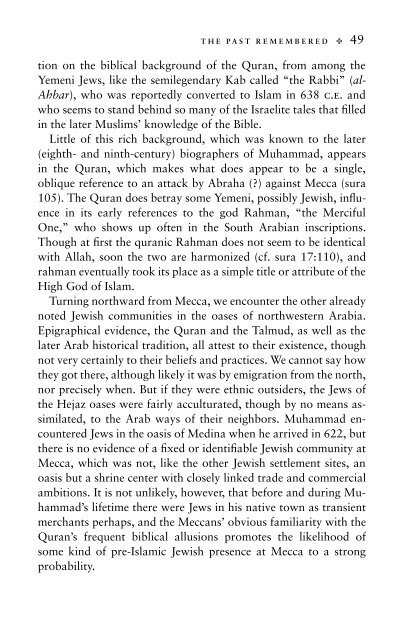Islam: A Guide for Jews and Christians - Electric Scotland
Islam: A Guide for Jews and Christians - Electric Scotland
Islam: A Guide for Jews and Christians - Electric Scotland
Create successful ePaper yourself
Turn your PDF publications into a flip-book with our unique Google optimized e-Paper software.
THE PAST REMEMBERED t 49<br />
tion on the biblical background of the Quran, from among the<br />
Yemeni <strong>Jews</strong>, like the semilegendary Kab called “the Rabbi” (al-<br />
Ahbar), who was reportedly converted to <strong>Islam</strong> in 638 c.e. <strong>and</strong><br />
who seems to st<strong>and</strong> behind so many of the Israelite tales that filled<br />
in the later Muslims’ knowledge of the Bible.<br />
Little of this rich background, which was known to the later<br />
(eighth- <strong>and</strong> ninth-century) biographers of Muhammad, appears<br />
in the Quran, which makes what does appear to be a single,<br />
oblique reference to an attack by Abraha (?) against Mecca (sura<br />
105). The Quran does betray some Yemeni, possibly Jewish, influence<br />
in its early references to the god Rahman, “the Merciful<br />
One,” who shows up often in the South Arabian inscriptions.<br />
Though at first the quranic Rahman does not seem to be identical<br />
with Allah, soon the two are harmonized (cf. sura 17:110), <strong>and</strong><br />
rahman eventually took its place as a simple title or attribute of the<br />
High God of <strong>Islam</strong>.<br />
Turning northward from Mecca, we encounter the other already<br />
noted Jewish communities in the oases of northwestern Arabia.<br />
Epigraphical evidence, the Quran <strong>and</strong> the Talmud, as well as the<br />
later Arab historical tradition, all attest to their existence, though<br />
not very certainly to their beliefs <strong>and</strong> practices. We cannot say how<br />
they got there, although likely it was by emigration from the north,<br />
nor precisely when. But if they were ethnic outsiders, the <strong>Jews</strong> of<br />
the Hejaz oases were fairly acculturated, though by no means assimilated,<br />
to the Arab ways of their neighbors. Muhammad encountered<br />
<strong>Jews</strong> in the oasis of Medina when he arrived in 622, but<br />
there is no evidence of a fixed or identifiable Jewish community at<br />
Mecca, which was not, like the other Jewish settlement sites, an<br />
oasis but a shrine center with closely linked trade <strong>and</strong> commercial<br />
ambitions. It is not unlikely, however, that be<strong>for</strong>e <strong>and</strong> during Muhammad’s<br />
lifetime there were <strong>Jews</strong> in his native town as transient<br />
merchants perhaps, <strong>and</strong> the Meccans’ obvious familiarity with the<br />
Quran’s frequent biblical allusions promotes the likelihood of<br />
some kind of pre-<strong>Islam</strong>ic Jewish presence at Mecca to a strong<br />
probability.
















